Testing Ground: Slow Listening
… slowness as awareness in process…
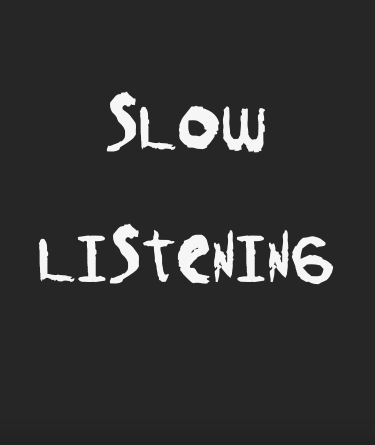
THE TYPEFONT USED IS CALLED 'MOTHER NATURE IS A LESBIAN'. IT IS CREATED BY BE OAKLY AT GENDERFAIL, AND IS BASED ON A PROTEST SIGN. IT IS OPEN SOURCE AND USED HERE AFTER ECONOMIC DONATION TO GENDERFAIL PRESS.
A (minor) invitation
(Given on a little piece of paper when greeting people arriving for Listening Event II)
Dear you,
For the next three hours you are invited to enter a space for Slow Listening.
An atmosphere of attention, care, knowing and not-knowing.
Please consider entering this room Slow-ly, whatever that means to you.
Find a place to rest your belongings and begin to orient yourself to the space.
When you are ready, make your way into the circle of chairs and sense the one that is there just for you.
Join in/us,
at your own pace.
Thank you for being here.
Sincerely,
Bureau for Listening and Slow Research Lab
Up-starting ritual #1:
[A series of rituals/practices/exercises/check-ins… to mark and attune each ‘workshop’ day. Each ritual will last 15 minutes.]
Walk as slowly as possible
– together as a group – perhaps shoulder to shoulder…
Walk for as long (or short…) as possible
—
We did this ritual at the centre of the parking lot of the meatpacker district – and were able to walk at a pace of 2 minutes pr. meter. We felt, that with time, we would have been able to walk much much slower… making it a question of practice, of balance…
“Deceleration (moving at a slower pace) is an important aspect of Slowness, but the crux of it is less about a register of speed than it is about awareness—and especially about shifts in perception and positioning that can be provoked when we commit to more expansive ways of being in and of the world.”
– Carolyn F. Strauss, ‘Seeking Radical Affection’ in Slow Spatial Reader (Valiz 2021)
“As we inhabit these forms, they shift our perception. Such an allowance awakens our capacity to know without needing to know. We come to know such not-knowing as the antecedent to the greatest potential. We remember the feeling as play, something abandoned long ago out of fear that it would never amount to anything.”
– Maria Blaisse & Siobhán K. Cronin, ‘Form As Passage‘ in Slow Reader (Valiz 2016, p.173).
Slow Listening – a group conversation
Tuesday the 27th of February
A meeting room at Art Hub Copenhagen
1 hour and 30 minutes.
Present: Carolyn F. Strauss, Amalie Sejersdahl, Randi Lindholm Hansen, Lukas Quist Lund.
Unedited AI generated transcription (apologies for spelling mistakes).
[To be revisited, sorting out speakers and fragmentized later on].
Up-starting ritual #2:
[A series of rituals/practices/exercises/check-ins… to mark and attune each ‘workshop’ day. Each ritual will last 15 minutes.]
1. Find a space in the room you would like to inhabit for the next 15 minutes.
2. Listen to the voice reading Being taken for Granite by Ursula K. Le Guin.
3. Listen to the second reading of the same text by the same voice.
4. When the reading stops, gather around the table at the center of the room.
5. Find two (chocolate)pebbles on the table.
6. On the first pebble, place an intention you would like to take with you into the day. Eat the pebble, you will now hold this intention in your body for the rest of the day.
7. On the second pebble, place an intention for the group for the day. Offer this pebble to someone else from the group to hold.
8. Swallow any intention you might have been trusted with, hold it in your body.
9. Start the day.
Up-starting ritual #3:
(Guided by Carolyn F. Strauss)
[A series of rituals/practices/exercises/check-ins… to mark and attune each ‘workshop’ day. Each ritual will last 15 minutes.]
We were honored to be welcomed by The Big Welcome, adapted by Kate Morales for the Slow Spatial Reader, and read by Carolyn F. Strauss at our Listening Event II.
Slow Listening as protest / strike / action / form of resistance…?

During our testing of Slow Listening as a possible protest/strike/action/form of resistance were we among others invited to listen inside of the Danish Parliament (did our listening affect the space, the people, the structures for decision making?); we placed ‘minor and tender invitation’ for Slow Listening around inside Parliament, along the streets, at the Danish Royal Library, Copenhagen Central Station (and more..); we installed possible slow listening banners, and conducted both a silent march and a Slow Listening Walk.

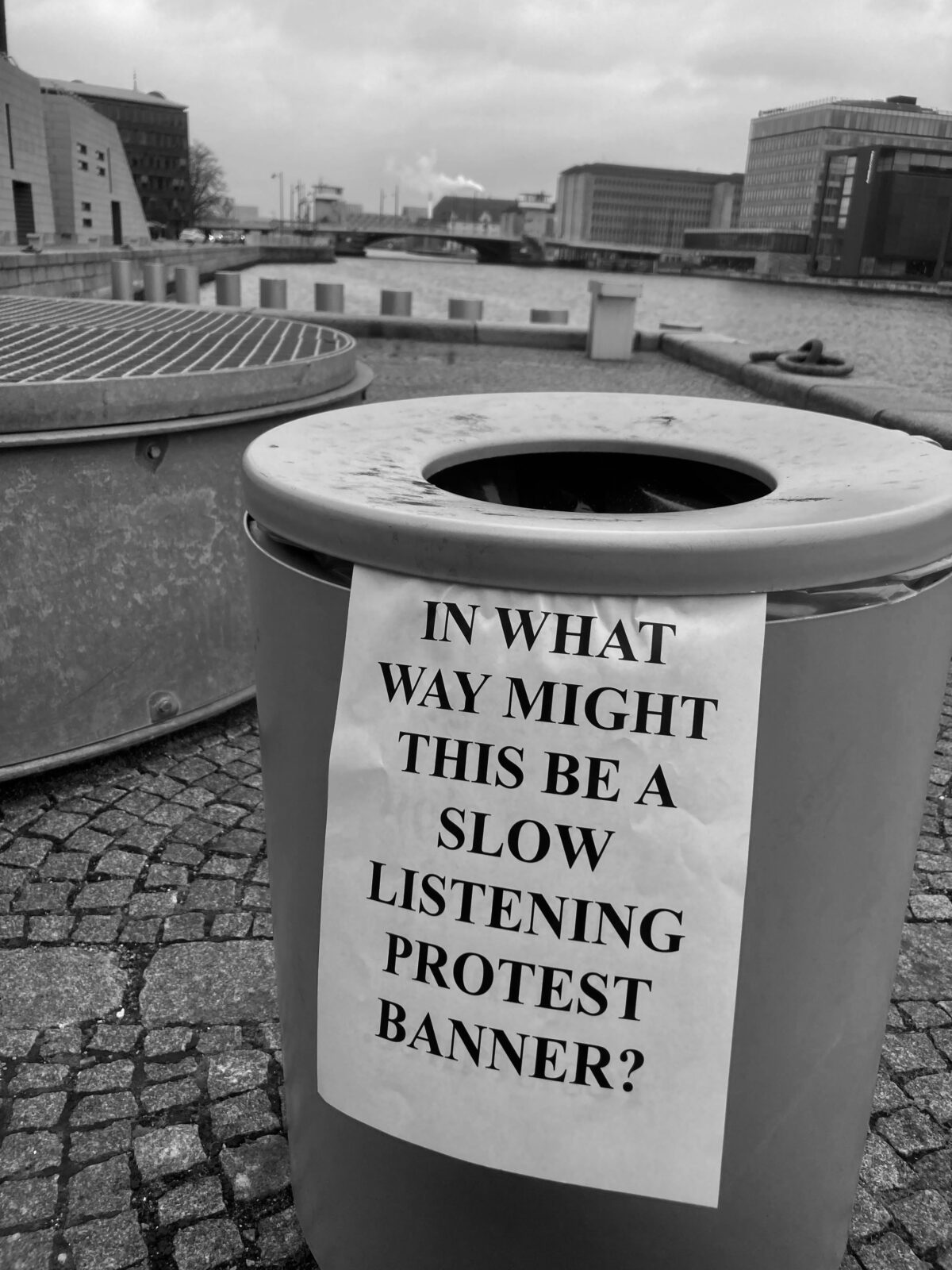
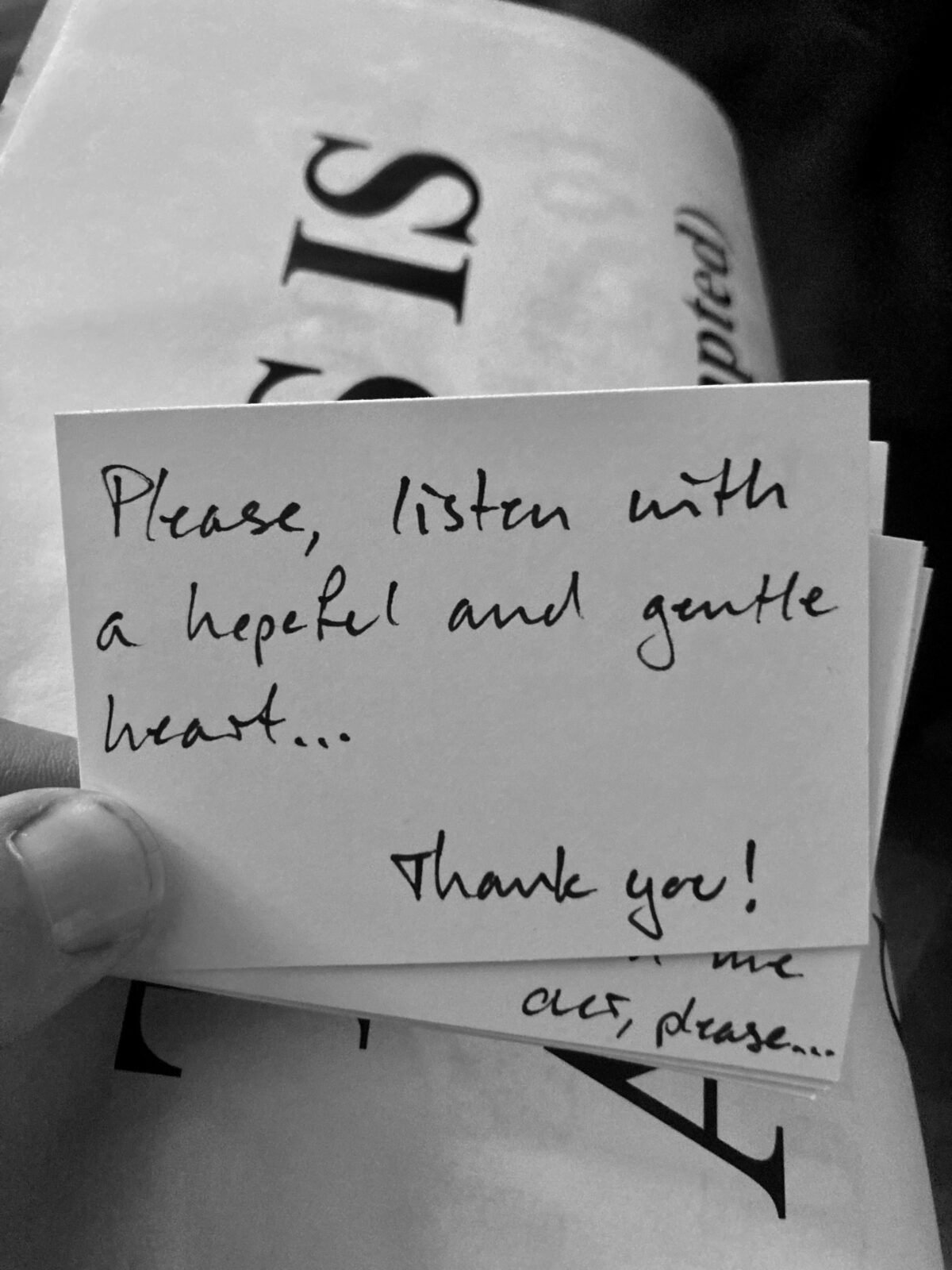
How may the vagueness, the failure, the softness, and the element of being unable to comprehend, known, and measure the effects of Slow Listening as an act of protest and resistance? – how may it affect beyond generations, communities, and histories?
How may these (elusive) elements and characteristics offer, or lead us, to a possible more sustainable and radical form of protest?
We also wonder in what way, we have or haven’t learned from past forms of protests and resistances? In what way are we able to listen to the resistance of non-and-more-than-human entities and forces? And what means of protest are we teaching future generations?
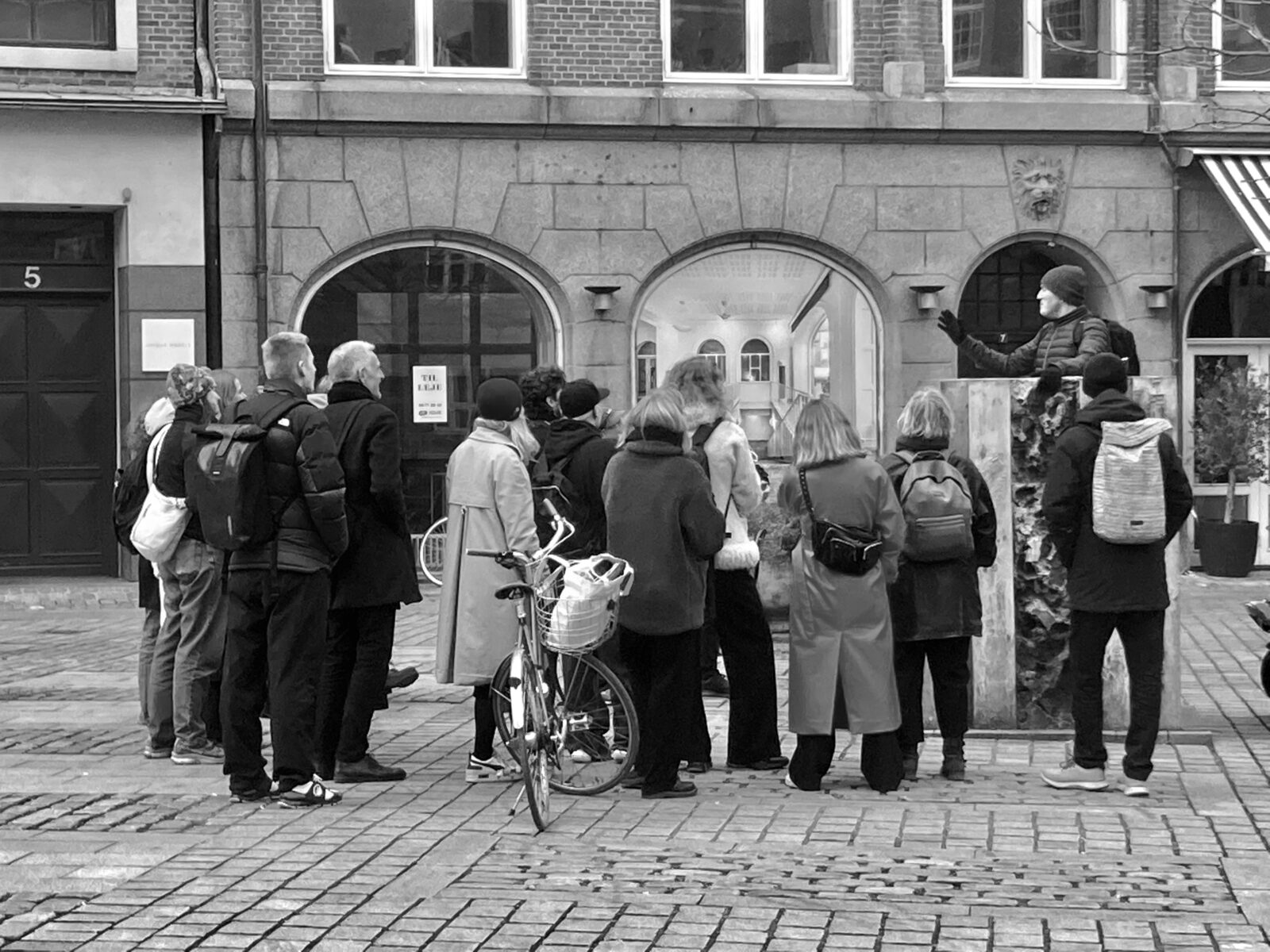

Invitation:
Start with a breath, or a touch on your body.
Honor the vibrations of how you feel that touch and how you take that breath.
Honor the rhythm of this touch and breath.
Give yourself time and care to hold your body here.
[…]
Where would you like to begin?
What do you need?
Let’s start with a breath
Ash McAskill, ‘Access and Atypical Creation’ in Slow Spatial Reader (Valiz 2021, p. 113-120).
Listening With Darkness
– a midnight-field-session on leap day of the 29th of February with artist/research Christine Hvidt.
—
The listening with darkness sessions explores ways of listening
with and to
what is and appears
in the darkness.
—
See introduction/instruction and ‘poetic’ documentation here.
A 10 minutes excerpt from the sound recording from Sydhavnstippen as location for the Listening With Darkness session:
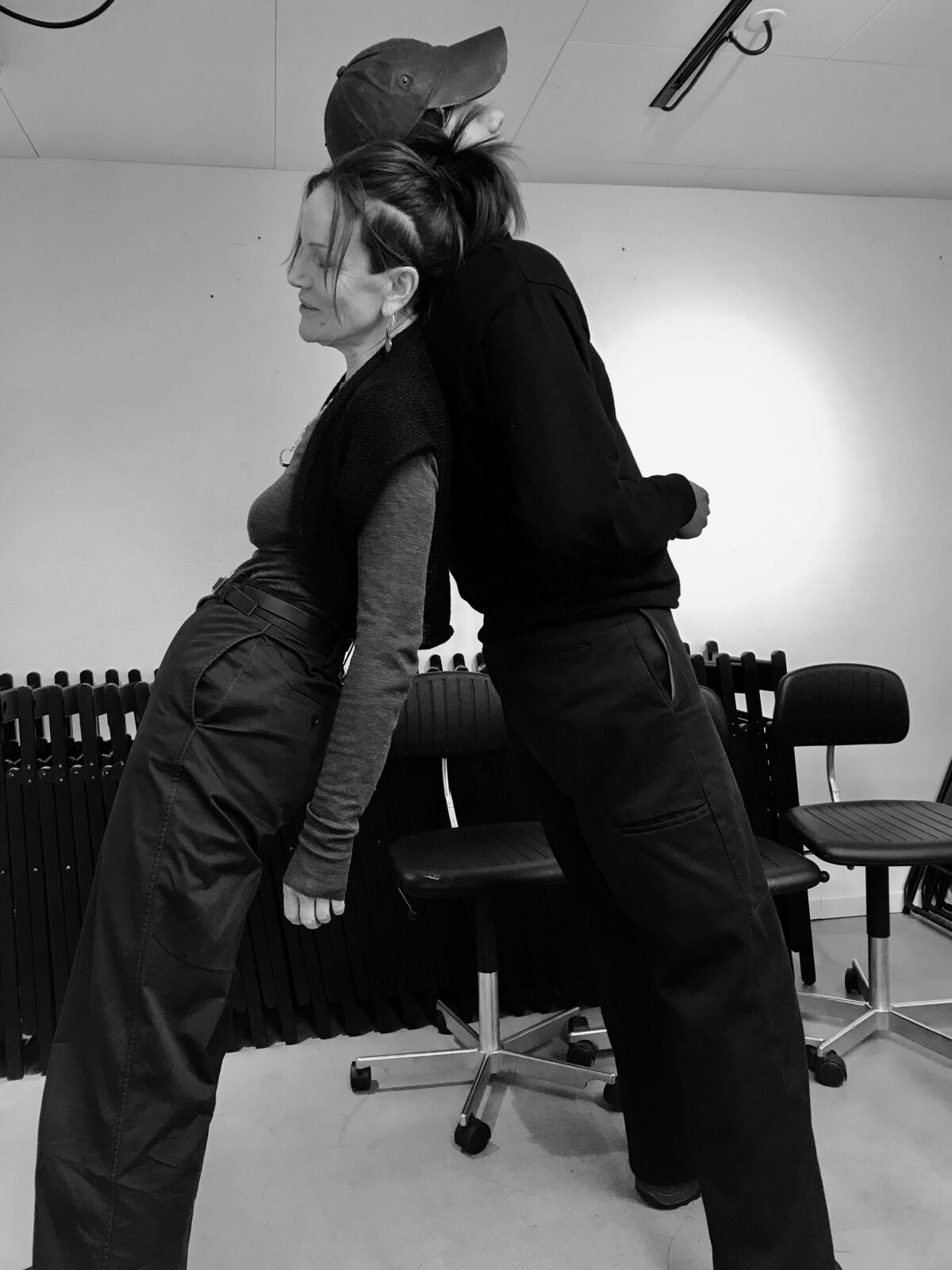
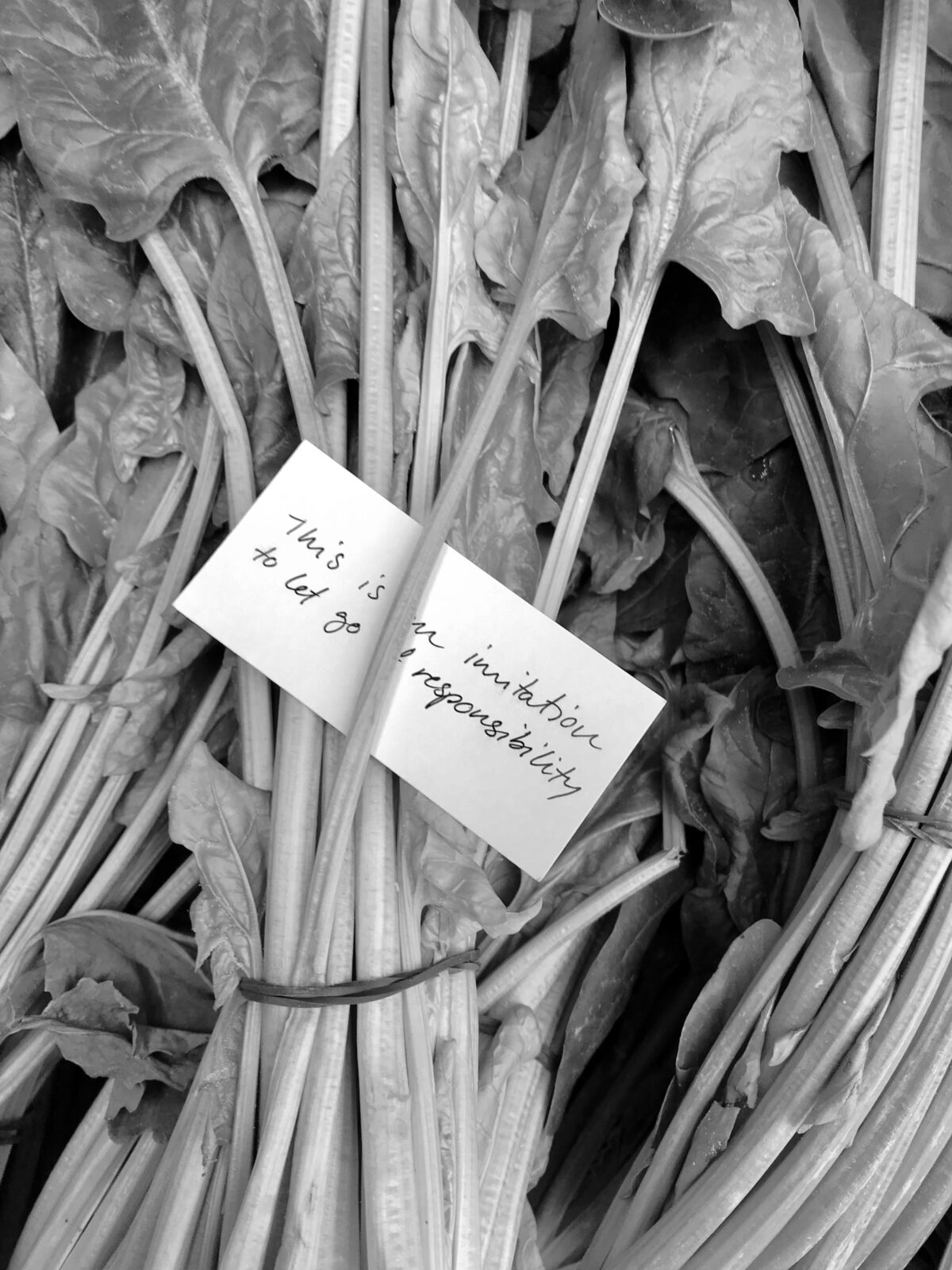

Up-starting ritual #4:
[A series of rituals/practices/exercises/check-ins… to mark and attune each ‘workshop’ day. Each ritual will last 15 minutes.]
Slow reading: a collective x (fifth) story (for 2 or more people)
Take a pen and paper.
Sit in silence for 7 minutes and write your own text. You can decide on a common topic to write about or write about what comes to your mind at this moment.
For the next 7 minutes read your story out loud and slowly. Everyone reads out loud at the same time and slowly, so your words intertwine with each other. If you finish your story, repeat it.
You can record the reading and listen to it afterwards to hear a collective new story that you have created from the slowness and your own stories.
A collective mingling reading of impressions and words connected to the ‘Listening with Darkness’ facilitated by artist/researcher Christine Hvidt.
(The recorded new story collectively created from up-start ritual #4)
Not all words was possible to pick up on the recording. Sometimes the words of four experiences and voices were spoken more singularly and coherently, like they were completing each other or simply having a dialogue, other times they merge more deeply together, mingling in-between each other creating unforeseen constellations and sounds. All together they make up something for themselves – a form of witness.
(The recording is of low quality, with sounds from a neighboring kitchen filling out a background.)
to be in darkness/ I was / encountering darkness / read it / to be in the darkness/ staring into the darkness / at midnight / encountering light / the darkness staring into / my soul / to be / lay / left / sinking into land in the darkness at the arrival / place / restlessness / staring with closed eyes / of a new day / was / dampers / welcomed / with an open cold body / the tree / to be in the darkness / how to proceed? / yet / for / the arrival of a new month / hug me for almost three hours / starting to dark-dream / to proceed / the time / to be in the darkness / that’s it / was mine / following / existence / the rhythm and conducting / for the arrival / of the grass / a new season / so slightly / I think / singing / I listened / now / and then / silence / of such darkness / always / to be in the darkness / but differently / with others / when / I lived / to be in the darkness / in northern Finland / listening / darkness / penetrating / to be / I did everything / to be / in the darkness / to see / me / having a dialogue with the wind / in layers / what is / to be in the darkness / drifting / making friends / tender darkness / it / was / rough / with unfamiliar shapes / in and out / and intriguing / what is / to be in the darkness / dark listening / making friends / in my mind / and then / with the / unknown / earlier i was me / perspective / yesterday / to be / of darkness / with / slowness / now i am unsure / in the darkness / the darkness / of night / an tree / have the darkness found me? / surrounded by light pollution / and / the darkness of the past / to be in the darkness / an old friend / is listening back / making sense / at the darkness of the future / of ever-changing contours / an old friend / left or right / is there a future? / to be in the darkness / laying down / the tree had hugged me / an old friend / and listening / for almost three hours / with all the time that I had / laying down / time / to be in darkness / slow existing / and being slow / I think / laying down / I listened / and being dark / darkness / the soul is changed / to be in the darkness / so ever tender
thank you
FRAGMENTS FOR SHARING
For Listening Event II our invited guests Carolyn and Christine and all members of Bureau for Listening wrote down and shared a series of little notes, fragments, comments and other written/spoken poetic constellations constructed to summarize the previous days of testing.
Possible Slow Listening protest/resistance banners?


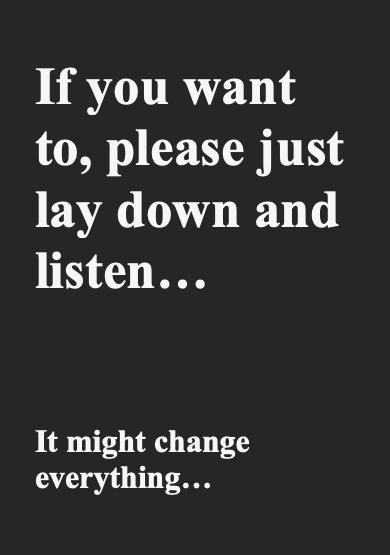
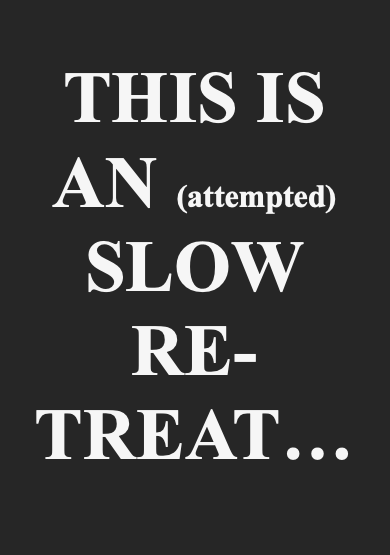
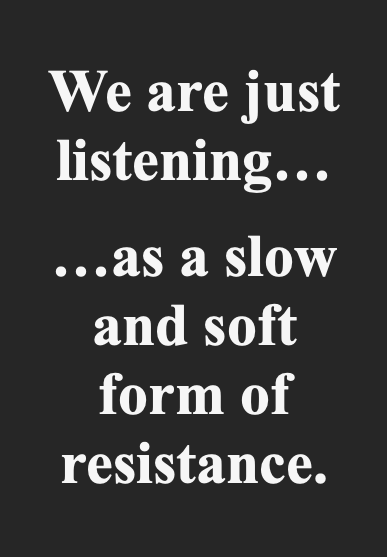

This week of the Testing Ground for Listening benefitted alot from Carolyn F. Strauss’ work with co-editing the book Slow Reader – A resource for design thinking and practice (Valiz, 2016), a forerunner for Carolyn’s editing of the publication Slow Spatial Reader – Chronicles of Radical Affection (Valiz, 2021).
Carolyn generously shared quotes and practices from these publications. We will here share a selection of voices from Slow Reader.
“A different way of listening is needed. Practicing profound contemplation, silencing our hyperactive egos and letting go of control and work. By always doing something, we only accelerate and reproduce what already exists.
Question: How can we allow ourselves to be bored, rest, or wonder?”
– Alessandra Pomarico, Situating Us, p.218
“What do we do in common? What could it be that will actually hold us together? I think we don’t know, and it is presumptuous to insert ideas about what that common should hold. That would almost be a colonial approach; that we already know what it should look like and how people should behave within it. We need to move towards the common in order to understand it.”
– Jeanne van Heeswijk, Preparing for the Not-Yet, p.49
“Learning to listen, breaking something of yourself in order to code yourself with new alliances.”
– Jeanne van Heeswijk, Preparing for the Not-Yet, p.44
“The miracle of the artistic approach is manifested not through a single word or concept but ‘in between.’ Between words and interruptions, restarts and counterpoints. If we are able to shift our aesthetic sense from a stable form to a dynamic process, we can easily understand the necessity to take the others into account. We understand that communication exists only because of the presence of the ‘other.’ The subject of the scene is not the speaker but the ‘conversation.’ The equivalence between subject and individual falters and we have the intuition of being singular plural, as Jean-Luc Nancy says.”
– Emilio Fantin, Art of Conversation and the Aesthetics of Process, p. 72-73
“Learning requires taking risks, passing through disruption, stretching boundaries, going beyond our limits, building patience. It takes effort and courage to open up to others, to include conflict, to recognize commonalities and core differences, to build trust, to venture into the unknown and the uneasy. It can be painful to share an open-ended process: we may critically reflect without ever actually undermining the system of rules and utilitarian ways we inhabit, without letting go of our habits and control, without relinquishing the pre-made tools that govern our thinking and are supposed to facilitate our gatherings. It is especially difficult to balance the sense of individuality and collectivity, it involves negotiations, even within ourselves, and an ability to share our own fragility. We need practice, we need discipline to be undisciplined, trusting that the process will open up something powerful and beautiful and magical.”
– Alessandra Pomarico, Situating Us, p.214
“There is a recent article by Spanish philosopher Marina Garcés, in which she gives a nice description of what it means to let go of your subjectivity. She talks about learning to listen, breaking something of yourself to code yourself with new alliances; but also allowing the dual, conflictive, nature of reality to become part of your self. She doesn’t use the word subjectivity, but she writes about being ‘affective,’ which in essence is to be sensitive to the way the other is in relation to you. She calls this ‘honesty with the real.’ […] It requires a willingness to listen. Not only hearing what the other has to say, but becoming sensitive to how someone else is.”
– Jeanne van Heeswijk, Preparing for the Not-Yet, p.44-45
“If you bring your focus to where you start, it can happen in every moment. We just have to be present, and stay there. We listen down to a deeper level that already knows a little more than we do, and then there is the connection. All the possibilities are there. We can enter at the smallest part. Where our expectations are small, but we are awake and listening.”
– Maria Blaisse & Siobhán K. Cronin, Form As Passage, p.173
“So training for the not-yet is a relational, dialogical, discursive process, and a frictional process as well. It is a field of tension where new senses of belonging are created, and it is also where the communal lies: in working and re-working the territory together in order to understand what it takes to make things grow, to make things connect. This constantly working at it is what we need. It is collectively trying to become while not already identifying what can be. That is something we need to learn how to practice. Letting go of our own subjectivity or breaking something or ourselves to allow other things to connect to us. It is a collective learning process in which we all have to let go of some of our ideas and our ideals in order to understand what it is that WE need. […] That is what I mean by the ‘not-yet’. How can we practice the collective without seeing that as aiming toward a fixed point in the future?”
– Jeanne van Heeswijk, Preparing for the Not-Yet, p.46.